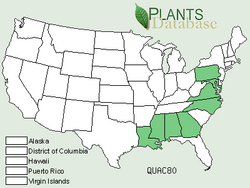Sawtooth oak
| Sawtooth oak |
|---|

|
| Scientific Classification |
|
| Binomial Name |
|
Quercus acutissima |

|
| Habitat Range |
The Sawtooth Oak is a very common tree eastern Asia and is one of the best trees for shade. The Sawtooth oak can be found in parks and on the sides of streets. In the summer the leaves are a yellow to green but in the fall they can be yellow to brown.
Anatomy
The Sawtooth Oak is one of the fastest growing trees that provides excellent shade during the summer. It is a very good tree to have because it can adapt to any kind of soil except for alkaline. The Sawtooth oak can also produce acorns in wildlife, and can grow up to 40'to 60' and can expand out to 40'to 60'.[1]The shape of the tree has a pyrimyal and is also round The Sawtooth oak has dark lustrous summer foliage and clear yellow to golden brown fall leaves in autumn, and have flowers that has a golden-brown color which bloom in late March into early April.
Reproduction
Ecology
The Sawtooth Oak is very common in eastern Asia and is widely planted in eastern America,which is a source of food for wildlife, it is also a landscape tree in some areas. In some areas it is said the the tree has escaped from cultivation sites, and in some areas of North America the sawtooth oak could impact the vegetation. Little is known about the trees habitat because they don't know where it comes from also its dispersal rate in the wild. The sawtooth oak are seen in confined to open, often disturbed areas, and dispersal is very slow, apparently due to limited dispersal of the acorns.[2] When the sawtooth oak is in the wild it is food for any wildlife and because of that it can result into naturalization of this exotic species.
References
- http://www.arborday.org/trees/treeguide/TreeDetail.cfm?ID=138
- http://www.ars.usda.gov/research/publications/publications.htm?seq_no_115=143169


